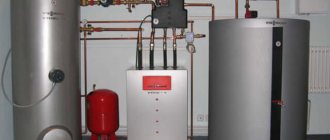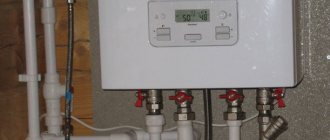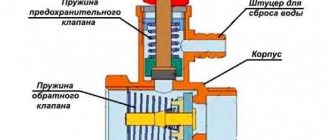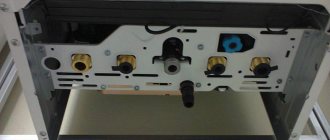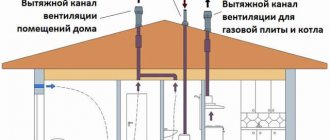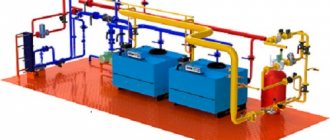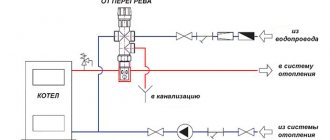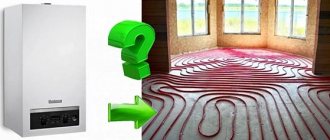A single-circuit or double-circuit gas boiler is equipment that makes our life in a house or apartment more comfortable. Manufacturers now produce a huge range of gas appliances that differ in power, functionality, and installation method. However, even the most expensive and reliable models can fail. Agree, it is not very pleasant to stay on a winter evening without warmth and hot water.
After analyzing the possible causes of breakdowns in gas equipment, we came to the conclusion that most often malfunctions occur due to the fact that the pressure in the expansion tank of a gas boiler or water heater is incorrectly set. In the article, we will figure out what an expansion tank is for, how to independently pump air into it and adjust the optimal pressure.
What is an expansion tank for?
In the process of heating, water tends to expand - as the temperature rises, the volume of the liquid increases. In the circuit of the heating system, pressure begins to build up, which can destructively affect the gas equipment and the integrity of the pipes.
The expansion tank (expansomat) acts as an additional reservoir, into which the excess water formed as a result of heating is squeezed out by pressure. When the liquid cools down and the pressure stabilizes, it is piped back into the system.
The expansion tank acts as a protective buffer, it dampens water shocks that are constantly formed in the heating system due to the frequent switching on and off of the pump, and also eliminates the possibility of air congestion.
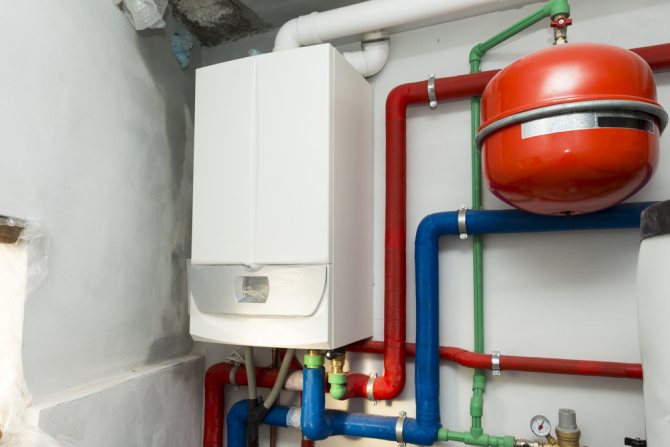
To reduce the likelihood of air congestion and prevent damage to the gas boiler by water hammer, the expansion tank should be mounted in front of the heat generator, on the return
There are two different versions of the damper tanks: open and closed types. They differ not only in design, but also in the method, as well as in the place of installation. Let's consider the features of each of these types in more detail.
Expansion tank, open version
An open tank is mounted at the top of the heating system. The containers are made of steel. Most often they have a rectangular or cylindrical design.
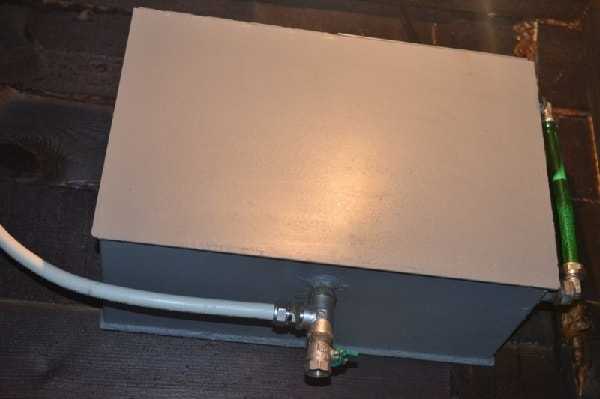

Usually such expansion tanks are installed in the attic or attic. Installation under the roof is possible. Be sure to pay attention to the thermal insulation of the structure.
There are several outlets in the structure of the open-type tank: for water inlet, cooled liquid outlet, control pipe inlet, as well as an outlet pipe for draining the coolant into the sewer. We wrote in more detail about the device and types of an open tank in our other article.
Open tank functions:
- controls the level of the coolant in the heating circuit;
- if the temperature regime in the system has decreased, it compensates for the volume of the coolant;
- when the pressure in the system changes, the tank acts as a buffer zone;
- the excess coolant is removed from the system into the sewer;
- removes air from the circuit.
Despite the functionality of open expansion tanks, they are practically not used anymore. Since they have many disadvantages, for example, the large size of the container, the tendency to corrosion. They are installed in heating systems that work only with natural water circulation.
Closed expansomat
In heating systems with a closed circuit, a membrane-type expansion tank is usually installed, it is optimal for any type of gas boiler and has many advantages.
Expanzomat is a hermetic container, which is divided in the middle by an elastic membrane. The first half will contain excess water, and the second half will contain normal air or nitrogen.
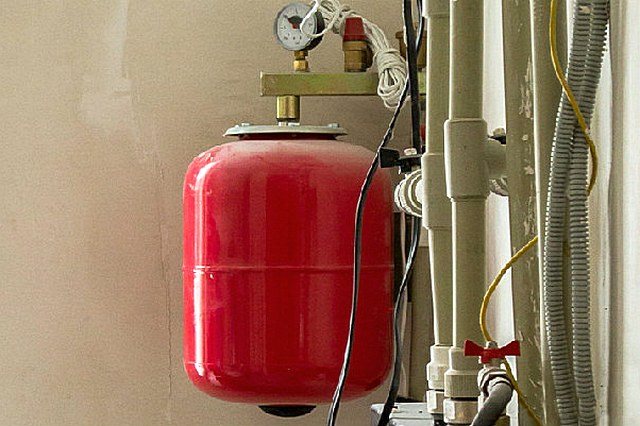

Closed expansion tanks for heating are usually painted red. There is a membrane inside the tank, it is made of rubber. Essential element for maintaining the pressure in the expansion tank
Diaphragm expansion tanks can be produced in the form of a hemisphere or in the form of a balloon. Which is quite suitable for use in a heating system with a gas boiler. We recommend that you familiarize yourself in more detail with the installation features of closed-type tanks.
Advantages of membrane types of tanks:
- ease of self-installation;
- corrosion resistance;
- work without regular topping up the coolant;
- lack of contact between water and air;
- performance under conditions of increased load;
- tightness.
Gas attachments are usually equipped with an expansion tank. But the additional tank from the factory is not always configured correctly and can immediately turn on in the heating operation.
Baksi boiler pressure drops when hot water is turned on
Sometimes, users face a problem when the pressure drops when hot water is turned on in the baxi boiler. This problem may just be associated with insufficient pressure in the expansion tank. The fact is that when the boiler is switched to the hot water preparation mode, the circulation pump pumps liquid in a small circle, i.e. only inside the boiler itself - through a secondary plate heat exchanger. At the same time, the heating circuit does not actually heat up and the coolant begins to cool down, the volume decreases and in the absence of compensating pressure in the expansion tank, the pressure of the heating system may drop and the boiler will have an error e10.
In such a situation, you can still consider the option of a breakdown of the heat exchanger itself (a gap between the plates) and the ingress of water from the heating circuit into the DHW system, but this is easy to check. To check, you need to turn off the cold water supply to the boiler and open any analysis valve. If, under such conditions, water flows from the tap, it is obvious that this is a coolant from the heating circuit and the heat exchanger needs to be replaced.
Remember, timely maintenance of the gas boiler will help avoid such situations and increase the service life of the unit.
We also recommend watching a video from one of the users, which clearly shows how to pump up the pressure in the expansion tank:


Hello dear readers. What is the importance of an additional expansion vessel for a double-circuit gas boiler? How to install it in the heating network.
Air pressure in the expansion tank
The indicator of air or nitrogen pressure in the expansion tank for different gas boilers will not be the same, it all depends on the type of equipment and design features. The standards are indicated by the manufacturer in the product passport.
Typically, the pressure in the new damper tank is 1.5 atm. But this setting may not be suitable for a specific heating system. Factory settings are easy to reset. For these purposes, there is a special fitting in the expansion tank housing (for some manufacturers it is a pumping valve), through which the air pressure is adjusted.


The nipple is located on the side of the cylinder air chamber. With its help, you can release excess pressure or, conversely, pump up the tank.
For the normal functioning of a gas boiler, it is necessary that the pressure in the membrane tank is 0.2 atm less than in the system itself. Otherwise, the heated water that has increased in volume will not be able to enter the container.
In small houses and apartments for closed heating systems, the pressure in the expansion tank is usually permissible in the range of 0.8-1.0 bar (atm).But not less than 0.7 bar, since many gas boilers have protection and the device simply will not turn on.
Check the pressure level of the tank annually. If pressure surges are noticed in the heating system, it means that air has escaped from the damper tank and must be pumped up.
EXPANSION tank For heating
1. Turn off the double-circuit boiler from the network.
2. Close the water supply taps to the design of the radiator.
3. Drain the water from the batteries.
4. Prepare expansive heating tank to work. Our system is installed from PP pipes. Based on this, in order to attach it, you will need an apparatus for soldering them and several corners, couplings and connectors. So that later you can remove the container for repair or replacement work, we use a specialized connector, in other words, "American".
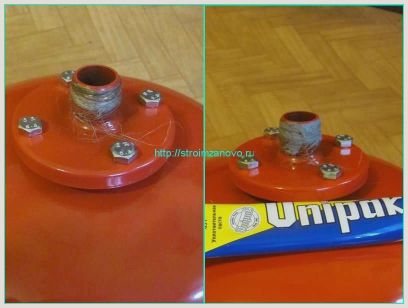

5. After making sure that there is no water in the heating system, proceed to the process of installing PP pipes.
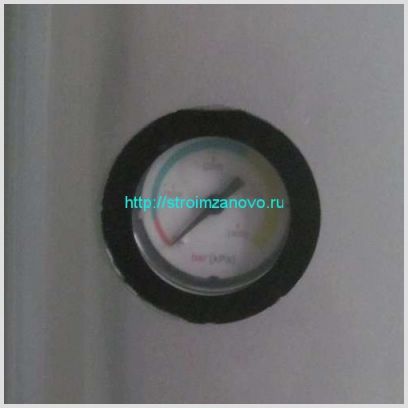

We turn on the apparatus for soldering polypropylene, setting the required temperature on it.
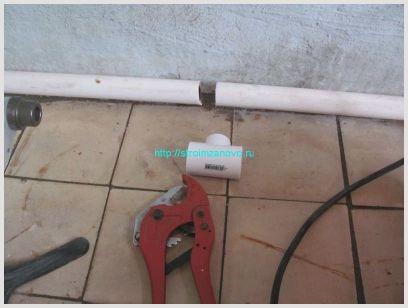

6. Connect the tank by twisting the "American" on it. We will place it on the floor, in the corner, near the wall, so that we can freely access it.
7. While there is no liquid in the pipes, unscrew the filter for preliminary water purification and rinse it.
8. At the same time, we will replace the cartridge in the flow filter, which is supplied immediately after the water supply pumping station.
9. Having put everything in place, open the fluid supply taps and fill the heating devices until the pressure is equal to 1.2-1.3 kPa.
10. Let us bleed the air from the pipes and close the air vents.
11. We turn on the boiler and heat the room.
The tank is set for an operating pressure of 1.8 kPa. If it increases in the system and exceeds the value of 1.8, the tank valve will open and excess water will go into it, and, conversely, with a decrease in pressure, water will go into the batteries. Thus, we ensured the continuous operation of the system by installing an additional expansion tank
for heating.
It is quite easy to check the tank operation. We pump it with air to a pressure of 1.6 atm and provide access to the nipple. Let's turn on boiler on gas. We will bring the pressure in the heating system to 1.5 atm. We begin to bleed air from the tank with a nipple. As soon as it falls below 1.5 atm, water from the system will begin to flow into the tank, and the arrow on the boiler pressure gauge will begin to fall. It means that expansive
the tank does not stop working and is connected correctly.
How to set the optimal pressure?
There are pressure gauges on the heating system, with the help of which the pressure in the circuit is monitored. On the expansion tank itself, there is no fitting for the installation of the measuring device. But there is a nipple or spool for the release and pumping of air or gas. The nipple is the same as on the wheels of cars. Therefore, you can check the pressure level and adjust it using a conventional car pump with a pressure gauge.


For pumping air into the expansion tank, even the simplest car hand pump with a pressure gauge or an automatic compressor is suitable.
Before releasing excess pressure or pumping air into the expansion tank of a domestic gas boiler, it is necessary to prepare the system. The car pressure gauge shows the value in MPa, the obtained data must be converted to atmospheres or bars: 1 Bar (1 atm) = 0.1 MPa.
Pressure measurement algorithm:
- Switch off the gas boiler. Wait until water stops circulating through the system.
- In the area with a hydraulic tank, close all shut-off valves and drain the coolant through the drain connection. For boilers with a built-in tank, the return flow is shut off, as well as the water supply.
- Connect a pump to the tank nipple.
- Pump air up to 1.5 atm. Wait a little for the remaining water to pour out, let the air in again.
- Close the valves of the stop valves and pump the pressure with the compressor to the parameters indicated in the passport or to the level - pressure in the system minus 0.2 atm. In the case of pumping over the tank, excess air is vented.
- Remove the pump from the nipple, screw on the cap and close the drain nipple. Pour water into the system.
It is possible to check the correct adjustment of the air pressure when the boiler reaches operating parameters.


If the tank is inflated correctly, then the gauge needle of the device during measurement will show a smooth increase in pressure without any jumps and jerks.
If the air pressure in the expansion vessel is incorrectly set, the entire heating system may malfunction. If the expansomat is over-pumped, the compensating properties will not work. Since the air will push the excess heated water out of the tank, increasing the pressure in the pipes of the heating system.
And with underestimated pressure readings of the compensating tank, the water will simply push through the membrane and fill the entire tank. As a result, when the temperature of the coolant rises, the safety valve will work.
Sometimes in double-circuit gas boilers, fuses are triggered even with the correct pressure setting of the built-in expansion tank. This indicates that the volume of the tank is too small for such a heating system. In this situation, it is recommended to install an additional hydraulic tank.
How to adjust the pressure in the expansion vessel?
The expansion tank has a spool mounted in the nipple for pumping or venting air. It is located on the side opposite to the connection point for the coolant. The tank nipple is very similar to the car nipple, so you can add pressure using a conventional auto pressure gauge pump. This can be done as follows:
- turn off the unit and wait about 8 minutes until the flow of the coolant completely stops;
- close the shut-off valves of the pipeline where the container is located and drain the water; at the tank built into the boiler, the supply and return are closed;
- open the nipple and connect the pump hose to it;
- pump air up to 1.5 atm and wait until all the liquid is poured from the container, then release oxygen;
- close the shut-off valves and pump up the pressure to the required pressure with a pump;
- remove the pump, put the cap on the nipple and close the drain connection;
- open the shut-off taps and draw water into the heating system;
- check the correct pressure in the tank.
When the unit reaches the operating parameters, the pressure gauge needle should not jump, but gain indicators smoothly.
The car pump pressure gauge is in MPa, not in bars. To find out how much MPa should be collected, it is taken as a basis that 1 Bar = 1 atm = 0.1 MPa.
Appointment of an additional tank of a double-circuit boiler
As a rule, built-in expansion tanks in gas boilers have a volume of about 6-8 liters. They are designed to compensate for the expansion of 120 liters of heating medium circulating in the heating system. Under normal operating conditions, such an expansion tank is enough for a small apartment or house.


When installing radiators of non-standard shapes and sizes, the heating system must be equipped with an additional expansion tank. Since these batteries hold more water
If the heating area is large, a warm floor is installed or there are many radiators in the rooms, the volume of the standard built-in tank will be small, since more water is used.
When heated, the excess coolant completely fills the tank. And since there is no free space in the tank, the water pressure increases in the heating system itself and an emergency discharge occurs with a safety valve. After that, the gas boiler will hardly be able to automatically turn on.
To avoid such negative consequences, an additional expansion tank with a membrane is installed in the heating system in the design for a double-circuit gas boiler. When the standard tank is full, the water will drain into the spare hydraulic tank. After cooling, the liquid returns to the radiators.
Expansion tank for heating
The expansion tank in by-pass circuits has a volume of 6-8 liters. Basically, this will be enough for its operation in traditional conditions. However, if you have a large heated area, heating devices cost a lot, and even they are original, more fluids are required to fill them. It happens that the volume of the tank supplied in the gas heater may not be enough.
In this case, the excess of heated water will fill the expansion tank completely, but the pressure in the batteries will still rise, since there is a lot of liquid. Then there will be an emergency release from the boiler until the pressure in the heating devices stabilizes.
Then, when the temperature decreases and the liquid cools down, it will come out of the tank. But since an emergency discharge has occurred, the pressure will drop to a point at which the boiler will not be able to automatically turn on. If you do not feed the heating system with water in a timely manner, and the outside temperature is low, its defrosting and destruction may occur.
To prevent such a negative scenario from happening, an additional expansion tank
for heating. In the case when the water fills the ordinary tank installed in the boiler, there will be no emergency discharge, now the liquid will go into the additional tank, and then it will go back to the heating devices. Likewise, the fluid volume of the system will remain unchanged.
Membrane tanks have different volumes. How to calculate expansion tank, we wrote in the publication Pressure drop in the heating system, and here we will not repeat ourselves. In this publication we will try to tell you how to install it on the system.
According to calculations, we need an additional expansive
heating tank with a volume of 10 liters. However, if you install it with a margin, it won't get any worse. Thanks to this, we bought a tank in the store that holds 12 liters of liquid.
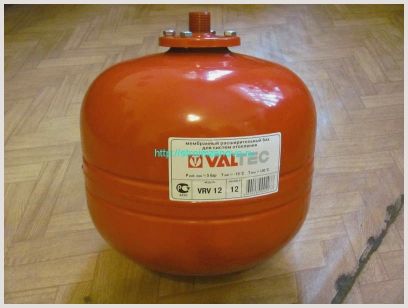

Before installing the tank, it should be adjusted to our conditions. Turn it upside down and remove the plastic cap. We will see a nipple for a familiar pump.
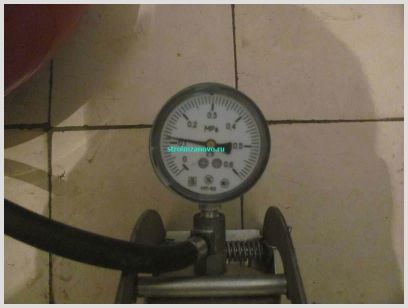

Expansion tank volume calculation
It is not difficult to ensure the stable operation of the heating system, the main thing is to choose the right volume of the expansion tank. The calculation of the volume of the expansomat should be made taking into account the most intensive operating mode of the gas boiler. At the first starts of heating, the air temperature is not yet very low, so the equipment will work with an average load. With the arrival of frost, the water warms up more and its amount increases, requiring more additional space.
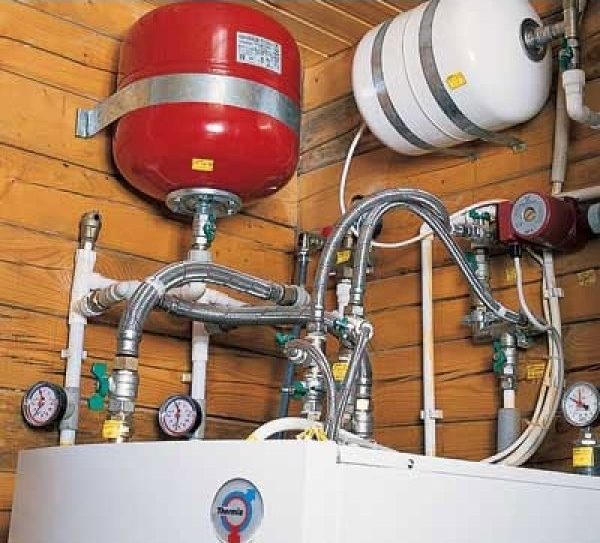

It is recommended to select a tank with a capacity of at least 10-12% of the total amount of liquid in the heating system. Otherwise, the tank may not cope with the load.
You can independently calculate the exact capacity of the expansion tank. To do this, first determine the amount of coolant in the entire heating system.
Methods for calculating the volume of water in the heating system:
- Completely drain the coolant from the pipes into buckets or another container so that the displacement can be calculated.
- Pour water into the pipes through the water meter.
- The volumes are summed up: the capacity of the boiler, the amount of liquid in the radiators and pipes.
- Calculation based on the power of the boiler - the power of the installed boiler is multiplied by 15. That is, for a 25 kW boiler, 375 liters of water will be needed (25 * 15).
After the amount of coolant has been calculated (example: 25 kW * 15 = 375 liters of water), the volume of the expansion tank is calculated.


There are many methods, but not all of them are accurate and the amount of water that can fit into the heating system can be much larger.Therefore, the volume of the expansion tank is always selected with a small margin.
The calculation techniques are quite complex. For one-story houses, use the following formula:
Expansion tank volume = (V * E) / D,
Where
- D - indicator of the efficiency of the tank;
- E - coefficient of liquid expansion (for water - 0.0359);
- V - the amount of water in the system.
The indicator of the efficiency of the tank is obtained by the formula:
D = (Pmax — Ps) / (Pmax +1),
Where
- Ps= 0.5 bar is an indication of the expansion vessel charging pressure;
- Pmax - maximum pressure of the heating system, on average 2.5 bar.
- D = (2,5-0,5)/(2,5 +1)=0,57.
For a system with a boiler capacity of 25 kW, an expansion tank with a volume of: (375 * 0.0359) / 0.57 = 23.61 l is required.
And although the double-circuit gas boiler already has a built-in tank of 6-8 liters, but looking at the results of the calculations, we understand that the stable functioning of the heating system without installing an additional expansion tank will not work.
Do i need an expansion tank for the baxi wall mounted gas boiler?
The volume of the built-in expansion tank of the baxi boiler is indicated in the characteristics and for the ECOFOUR series is 6 liters, in order to answer the question of its need for a separate heating system - you need to know the total volume of this system.
It is not so difficult to calculate it: the filling volume of the boiler and radiators is in their characteristics, and the filling volume of the pipelines can be calculated knowing their diameter and total length. Water, after heating to 80 degrees Celsius, will increase in volume by about 4-5%, therefore, the recommended volume of the expansion tank is 8% of the total volume of the heating system in the case of filling with water and 12% in the case of using antifreeze as a heat carrier (thermal coefficient expansion of antifreeze more). Thus, a standard expansion tank will be sufficient for a heating system with a volume of up to about 75 liters when using water and a volume of up to 50 liters when using an anti-freeze liquid.
These figures are conditional (with a margin) and when selecting the capacity of the expansion tank, one must be guided by the design calculations of a specific heating system, or the manufacturer's recommendations.
In most cases, the built-in boiler tank is quite sufficient and the decision to use a separate additional tank is made by specialists at the design stage.
